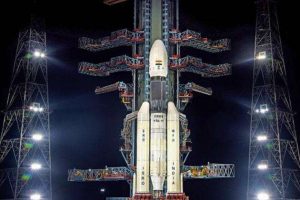JULY 21, 2019
 Chandrayaan-2 will make India the fourth country after the United States of America, the erstwhile Soviet Union and China to land on the lunar surface. (PTI)
Chandrayaan-2 will make India the fourth country after the United States of America, the erstwhile Soviet Union and China to land on the lunar surface. (PTI)
The Chandrayaan-2 spacecraft will spend six additional days in Earth’s orbit and 15 fewer days around the Moon before it lands on the day that was originally planned, Indian Space Research Organisation (Isro) scientists have said, giving details of how the mission will stick to its timelines despite a week’s delay.
The 20-hour countdown for the lift-off at 2.43pm on Monday began on Sunday evening, six days after the July 15 attempt had to be aborted with just 56 minutes and 24 seconds left on the clock. The delay was forced by a leak in the engine of the GSLV-MkIII rocket that is to carry the Chandrayaan-2 into space.
“The lander-rover was designed to carry out experiments during one lunar day — or 14 Earth days. To ensure that the scientific experiments can be carried out for the entire duration, it was essential that the lander-rover descend to the Moon on the same day,” said an Isro official, asking not to be named.
In order to catch up, the scientists have made tweaks that are necessary to keep in place a careful choreography of movements crucial to ensure the spacecraft does not overshoot the Moon, crash into surface or land at a spot not designated for the mission.
“These are minor adjustments to the orbit and will not affect the mission in any way. During the initial planning of the mission, some redundancies had been introduced to ensure that the mission could be completed even if there were any glitches,” the official said.
The adjustments involve keeping the spacecraft in Earth’s orbit for six more days than planned. At this stage, the Chandrayaan-2 will use the Earth’s gravity to slowly gather speed before it slingshots its way to the moon.
The journey to the Moon will take place over seven days, two days more than previous plan.
The biggest change will be in the time the Chandrayaan-2 spends in the lunar orbit. To gain the lost time due to the delayed launch and the additional days around Earth and in the journey in between, the time spent in the lunar orbit will be reduced from 28 days to 13 days, the official quoted above added.
On Day 48 after the launch, the lander (containing scientific gauges and a robotic rover that will roll out onto the surface) will detach and begin a five-day descent that will involve “fine” and “rough” braking manoeuvres involving thrusters.
Chandrayaan-2: India’s Most Ambitious Space Mission Yet
The lander will attempt a soft landing near the south pole between two craters, Manzinus C and Simpelius N, and study the shadowy regions within. The spot holds significance because the first Chandrayaan mission, in 2008, dropped an impactor near the Sackleton Crate on the south pole and found conclusive proof of water in the lunar soil, rocks and atmosphere.
That point was named the Jawahar point since the landing took place on the birth anniversary of India’s first prime minister Jawaharlal Nehru.
Chandrayaan-2 will make India the fourth country after the United States of America, the erstwhile Soviet Union and China to land on the lunar surface.
This will also be the first space mission to rove on the south pole of the moon looking for water, ice and cold traps that could preserve the history of our solar system.
At least 7,500 people will witness the launch of the mission from Sriharikota, Andhra Pradesh.
“The registrations for the viewing gallery opened on Friday evening and within a couple of hours, the registrations had to be closed. Isro had decided to give preference to those who had come to Sriharikota on July 15 and could not witness the launch. About 80% of the registrations are of those who had come here previously,” said the Isro official quoted above.
Isro opened the viewing gallery in April as part of its outreach initiatives.
Courtesy/Source: Hindustan Times









































































































